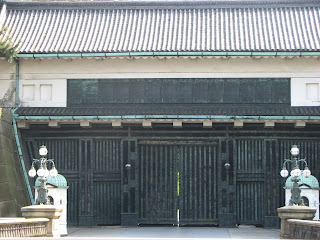What comes to our mind when the word 'Japan' is whispered in our ear?
My daugter would say ... Animax! Harajuku! Shibuya!
Some guys might say .... Honda YZR M1 Motorbike! Hidetoshi Nakata!
I would say .... a modern and expesive country!
Well, that's what I thought before I went to Japan last summer. It turned out that Japan is a country which is very modern with a well preserved tradition.
For instance, we would find skyscrapers in every corner of Tokyo.
Bold during the day,

and glittering at night,

However, when I asked my colleague where the centre of Tokyo ... the answer is "Area around the Imperial palace." The palace is open for public except for Monday and Friday. Unfornately I was there on Monday, but still got a glimpse of the palace beauty.



In this vast park, after Japan loose the WW II in 1945, many Japanese gathered there, bowed and paid homage to the Emperor, apologizing because they loose the war.
Besides the palace, Tokyo has many gardens whish is maintained well,


and some shrines, including the controversial Yasukuni Shrine.

The Yasukuni Shrine is controversial as the Japanese believe that all the souls of the Japanese soldiers, including the notorious World War II soldires, return there. Whenever Japan Emperor or Prime Minister prays at the Shrine, the whole world get angry!
All over Japan we still can find palaces from the Shogun Era like the one in Kitakyushu here

which was opened for public to see and learn what hapened during the Shogun Era
 (Good that when I was at school I paid good attention to Japan history! .... So I was kind of connected to most items displayed in the palace).
(Good that when I was at school I paid good attention to Japan history! .... So I was kind of connected to most items displayed in the palace).Even many Japanese practice Buddhism, Shinto shrine still exist accross Japan ....

Shinto is the indigenous spirituality of Japan and the Japanese people.
The transportation in Japan is very modern, from the local made vehicle (Toyota, Honda, Suzuki, Yamaha, .... I could go on forever ...) to the fast bullet train that can run 300 kilometers per hour

however, there is still place for bicycles.

Modern fashion has become 'a must'among the teenagers' and the youth's make up and clothing;
At Omotesando,

Shibuya,

The airport ...

Let's see what Harajuku got to offer ....

 Colorfull, but I still don't understand why my daughter crazy over this Harajuku things though ....
Colorfull, but I still don't understand why my daughter crazy over this Harajuku things though ....However, with this modernism, we still find the Kimono sold in the prestige Ginza area.

Yes, in Ginza.

And this waitress serving japanese Food in Japanese traditional outfit

We almost forget the food aren't we? Yes, the famous Japanese foooood ....
With the invasion of McDonald, KFC and other so called modern junky food, the Japanese food is still unbeatable. It is an art of its own.
The appetizer,

The sauce and spice,

The main menu ...
in this case the famous Tempura,
What I love the most is they include the carbohydrate food at the end of the main dish. Good for diet eh ....

And completed with a light dessert,

Sometimes we get a touch of western idea in a bowl of ice cream.

Not only the food, the clothing, the tradition; one time I saw a parking officer stood in the middle of the road to stop the coming raffic to allow the other vehicles got thru. Once he completed his job, before he left the road, he bowed to the coming traffic ... Wow, I bet I won't find this in other part of the world! I thought they just bow to the elderly or honored guests.
Well, Japan is indeed the country full of tradition. And, it is a proof that being modern does not mean we have to forget our root.
(About the price? If we shopped in Ginza or Omotesando, get ready to get broke. But Shibuya and Harajuku is OK for me. I got some nice teenager stuffs for my teenage girl and her friends. Souvenirs also availabe at the airport and the price is ok).